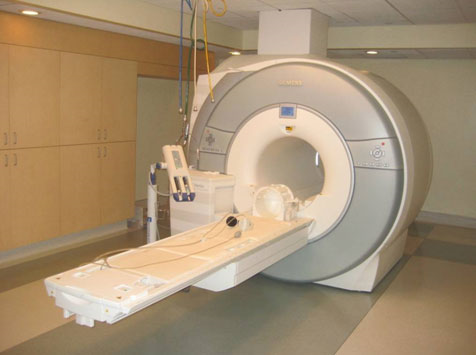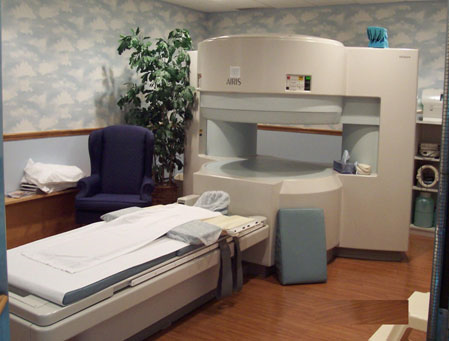What Is MRI?
Magnetic resonance imaging (MRI) is an examination that uses a magnetic field and pulses of radio wave energy to make pictures of organs and structures inside the body. The area of the body being examined is placed inside a special machine that contains a strong magnet. An MRI does not use radiation (X-rays) and is a non-invasive examination.
MRI examination is performed by a radiographer. The pictures or images are interpreted by a radiologist.
MRI Equipment
An MRI scanner is a device in which the patient lies within a large, powerful magnet. The MRI machine uses a large magnet and a computer to take pictures of the inside of the body. Patient will lie on a moveable examination table that slides into the center of the magnet. During the examination pictures of the body parts are taken. Pictures from an MRI scan are digital images that can be saved and stored on a computer. The pictures can then be examined on a computer monitor and printed on films.
Some MRI units, called short-bore systems, are designed so that the magnet does not completely surround the patient; others are open on the sides (open MRI). These units are especially helpful for examining patients who are fearful of being in a closed space and for those who are very obese.
Image 1: MRI Scanner
Source: www.nickdoeshockey.com
Image 2: Open MRI
Source: www.weissandnewberrymds.com
MRI Examination
The patient will be placed inside a large cylinder-shaped tube surrounded by a circular magnet. When the patient first lie on the MRI table, the radiographer will position an imaging coil around the body part being examined.
The examination usually take about 30 to 60 minutes depending on the body parts being examined.
Common MRI Examinations
MRI is done for many reasons. It is used to find problems such as tumors, bleeding, injury, blood vessel diseases, or infection. MRI also may be done to provide more information about a problem seen on other radiological examinations. MRI examinations are usually performed for the following body parts:
- Head.
- Chest.
- Blood vessels.
- Abdomen and pelvis.
- Bones and joints.
- Spine.
Preparation For MRI Examinations
Before the examination
Before MRI examination, tell the doctor and the radiographer if you:
- Are allergic to any medicines.
- Are or might be pregnant. An MRI usually is not done during pregnancy
- Have any metal implanted in your body. This helps the doctor know if the examination is safe for you. E.g cochlear (ear) implant; clips used in brain surgery (aneurysm); cardiac pace-maker; metallic joint prosthesis. The MRI magnet may cause problems with these devices or might make some of the detailed MRI images blurred.
- Have an intrauterine device (IUD) in place. An intrauterine device (IUD) with metal may prevent the doctor from seeing the uterus clearly.
During the examination
You will be asked to change into a hospital gown and remove all metal and electronic objects. Metal and electronic objects are not allowed in the examination room because they can interfere with the magnetic field of the MRI machine. Do not wear any jewelry including rings, earrings, necklaces, or watches. Take off any clothing that has metal hooks, buttons, zippers, or other metal items on it and anything metal that is on your body such as the following:
- credit cards and hearing aids, all of which can be damaged;
- pins, hairpins, and similar metallic items, which can distort MRI images;
- removable dental work;
- pens, pocketknives, and eyeglasses.
You will need to leave them in a locker provided.
The radiographer will help you lie on a moveable examination table that slides into the center of the magnet. The body part being tested may be kept in place with a cradle or straps to hold it very still.
You will need to lie still for a period of a few second to a few minutes while the series of images are being recorded (when you hear a banging sound). You can breathe freely during this time. You may, in some cases, be allowed to move slightly between scans, but not so much that your position changes.
Sometimes a dye or contrast agent is injected into your veins in your hand or arm to enhance how certain tissues or blood vessels look in the images.
MRI Result
After the MRI scanning is completed, the computer generates visual images of the area of the body that was scanned. These images are interpreted by a radiologist in the form of a radiological report. The report and MRI images are given to the doctor treating the patient. The doctor can then discuss the results with the patient and/or family.
Experience in MRI
MRI exams are normally painless. However, some patients feel uncomfortable to remain perfectly still for some time during the examination. Others experience a sense of being closed-in (claustrophobia). It is normal for the area of your body being scanned to feel slightly warm. If it bothers you, notify the radiologist or radiographer by pressing a ‘buzzer’ given to you at the beginning of the examinations or talking to them. They can see, hear and speak to you at all times throughout the examinations using a two-way intercom.
| Last Reviewed | : | 11 November 2013 |
| Writer | : | Mohd Syubli bin Adnan |
| Accreditor | : | Daud bin Ismail |









